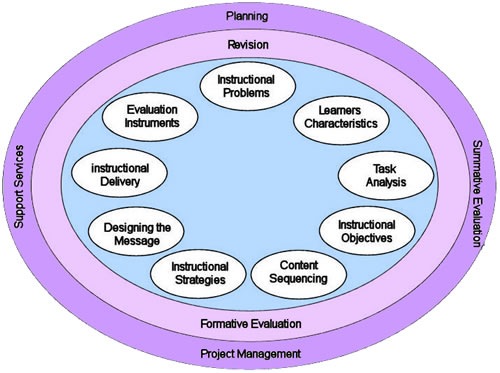Instructional Design Models, Theories & Methodology:
Ross and Kemp Model
by Katrina Strauss
(Also referred to the Morrison, Ross, and Kemp (MRK) Model)
What is this Instructional Design Model?
This model represents flexibility in planning depending on the circumstances you are under such as money and time constraints (Ho). Basically, you adapt your materials and instructional strategies to the classroom environment you are placed in.
The Ross and Kemp Model is composed of nine components that are part of a cycle of planning, design, development and assessments. The parts are not necessarily used in a sequential fashion. They are independent components that are part of a system of design. (Hanley, 2009)
Before using this model, the instructor needs to assess:
1) required level of learner readiness;2) instructional strategies and media that are be most appropriate for the content and the target population3) level of learner support required4) measurement of achievement5) strategies for formative and summative evaluation
There are nine key elements to the instructional design:
- Identify instructional problems, and specify goals for designing an instructional program.
- Examine learner characteristics that should receive attention during planning.
- Identify subject content, and analyze task components related to stated goals and purposes.
- State instructional objectives for the learner.
- Sequence content within each instructional unit for logical learning.
- Design instructional strategies so that each learner can master the objectives.
- Plan the instructional message and delivery.
- Develop evaluation instruments to assess objectives.
- Select resources to support instruction and learning activities.
Visual Representations
These elements can be represented in a oval shape to represent the systematic approach versus a linear approach to design. The revision/formative evaluation oval represents that instruction design can be revised at each stage of planning based on constraints like time or money. The outer oval represents the post-instructional activity (summative assessment) and includes the components required both for the project itself while it is in development, and afterwards to support the actual instruction. (2009)

The ADDIE model can be applied to the Kemp Model becuase they "both consider instruction from the perspective of the learner. Both include stages for analysis, design, development, implementation, and evaluation" . (Munoz, 2011).

Who's is this for?
This model is designed to be flexible for classroom teachers who may not have a lot of experience with instruction design. It is not a step by step process. "This model emphasizes the inter-dependencies of each step in the process, highlights the importance of the evaluation, and recognizes more environmental factors in an educational setting, i.e. the resources and the support (budget, facilities, time, equipment, personnel and materials)." (Kemp, 1985)
How it's different:
This model has three elements that differentiate it from some other models (The Herridge Group Inc., 2004): 1) instruction is considered from the perspective of the learner; 2) the model takes a general systems view towards development (model components are independent of each other) with instructional design being presented as a continuous cycle 3) the model emphasizes management of the instructional design process. According to Siribaddana (2009), this theory is the most widely used because the designer is not "confined" to a step by step, inter-dependent, model. The designer has more freedom in using the elements that are convenient for the most effective instruction.
A comparison of The MRK model to other models (Herridge, 2004)

References
Hanley, M. (2009, June 10). Discovering Instructional Design 11: The Kemp Model [blog]. From: http://michaelhanley.ie/elearningcurve/discovering-instructional-design-11-the-kemp-model/2009/06/10/
The Herridge Group Inc. (2004, December). The Use of Traditional Instructional Systems Design Models for e learning.(p. 10) From http://www.herridgegroup.com/pdfs/
The%20use%20of%20Traditional%20ISD%20for%20eLearning.pdf
Ho, W. (date unknown). ISD Models. From http://www.personal.psu.edu/users/w/x/wxh139/Practice_1.htm
Kemp, J. E. (1985). The instructional design process. New York: Haper and Row. From http://www.personal.psu.edu/users/w/x/wxh139/Kemp.
Siribaddana, P. (2009, December 15). Instructional Designing: The Kemp Model [web post]. From: http://www.helium.com/items/1682282-what-is-kemp-model-or-mrk-model-or-instructional-design-model-kemp
